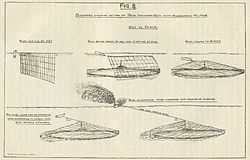Indicator net
Constructed using light steel nets, indicator nets were often anchored at various depths to the sea bed around Allied naval bases during both world wars. They were intended to entangle U-boat traffic of the enemy, even though the submarines often managed to disentangle themselves and escape before being blown up by depth charges.
Predominantly deployed by the Royal Navy as a means of discouraging enemy submarines from entering Allied waters, indicator nets were used extensively during the war. Individual nets were sometimes as much as 100 metres (330 ft) in length.
Instead of being used as the sole anti-submarine measure, indicator nets were often mixed with extensive minefields and patrolling warships. Sometimes mines were attached directly to the nets, thus reducing submarine survival chances.
After a submarine became entangled in the net, a marker buoy attached to the net drifted along the water's surface indicating an enemy below. The first example of indicator nets causing the destruction of a U-boat occurred at Dover when the U-8 became entangled on March 4, 1915.
The British also used indicator nets attached to converted fishing boats. The boats were armed with guns and depth charges to attack any submarine that became entangled in their net. A number of these boats were deployed in the Mediterranean as part of the Otranto Barrage, to block the Strait of Otranto. On 12 May 1917, the Austro-Hungarian submarine SM U-6 was entangled in one of the nets. The captain surfaced in an attempt to cut the net free and the surfaced submarine was subjected to ineffectual gunfire from the fishing boats. The submarine was scuttled as its propellers had been fouled by the net and escape was impossible. All the crew were rescued.[1]
See also
References
- Citations
- ↑ Halpern (2004), p.37
- Bibliography
- Halpern, Paul (2004). The Battle of the Otranto Straits: Controlling the Gateway to the Adriatic in World War I. Indiana University Press,. ISBN 025311019X.
| Wikimedia Commons has media related to Anti Sub Warfare. |
